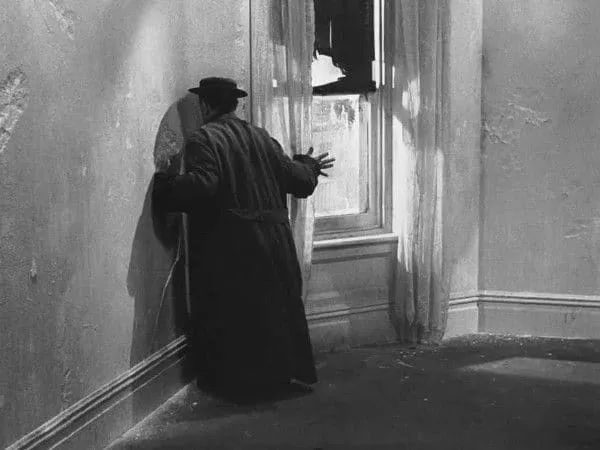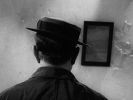Eye For Film >> Movies >> Film (1965) Film Review
Film
Reviewed by: Amber Wilkinson

This 22-minute short represents Samuel Beckett's only foray into filmmaking but its themes fit snugly in with the rest of his output. Like much of Beckett's work, the concept is at once nose-bleedingly high and intellectual, and yet, in execution, it becomes a lot more simple and humanistic. The two main protagonists are a man called O (which stands for Object) and E (which stands for Eye), represented by the camera, which follows O's progress.
O could easily be Waiting For Godot's Vladimir or Estragon, transplanted to an urban environment, muffled as he is in layers of clothing, a handkerchief and a pork pie hat on his head. Although the film is concerned with scrutiny - from others and, most importantly, the self - we are deliberately prevented from seeing O's face for much of the running time. Buster Keaton is a good choice as the central character, given his ability with body language, and his comic timing lends a scene involving a cat and dog some extra laughs. O doesn't like to be watched, scurrying away and freezing when E gets too close. Side characters in the film, although observers themselves, also rear up in horror when faced with the lens at close quarters.

One of Beckett's constant themes was a sense of existential dread - although his embrace of the Theatre of the Absurd and his use of Music Hall patter mean that comedy is frequently its close bedfellow. In 1953's Waiting For Godot, Beckett's characters find themselves "stuck", unable to move from the stage, and by a decade later, the protagonists of Play are also physically confined, each in their own funeral urn, a diminution of movement that would reach its peak in 1972's Not I, where Billie Whitelaw's mouth was the only thing visible as her character rattles through a monologue. O is stuck, too, increasingly trapped by his inability to dodge the gaze, first of people and animals and finally himself. In sharp contrast to Beckett's plays, however, words don't just fail, they are never used, with the only moment of sound given to a woman on the street telling her husband to "Shhhhh".
The presence of Jean Vigo collaborator and 12 Angry Men lensman Boris Kaufman behind the camera pays dividends. He shows command of light and texture, from the film's first close-up of wrinkled skin and O's blinking eye and its similarity to the wall he scurries alongside, to the way the camera roves around the walls of the room where O hides out.
Viewers with a penchant for the intellectual will no doubt get a kick out of Beckett's interrogation of George Berkeley's "esse is percipe/to be is to be perceived", while film buffs will no doubt note his influence on the likes of Bela Tarr, but there's plenty here on an emotional level as well. We feel O's anxiety as he repeatedly checks for his pulse, his fear as he tries to cover up the mirror in the room he holes up in and sense his ruefulness as he flips through photo moments from his life. Open to interpretation, Film is ultimately as much about the way that you perceive it as the way Beckett intends it to be perceived.
Reviewed on: 01 Jun 2017
















